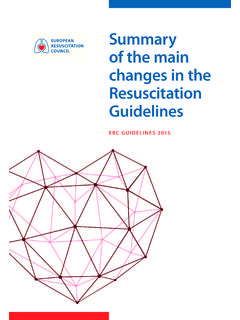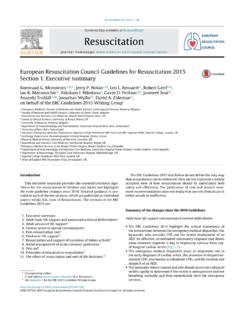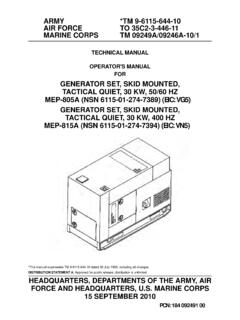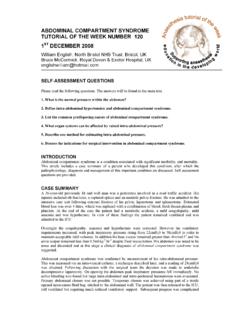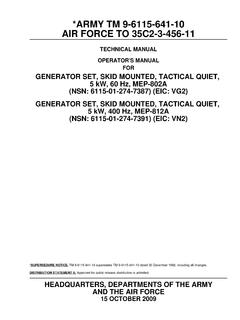Transcription of Contents lists available at ScienceDirect …
1 resuscitation 95 (2015) 223 248 Contents lists available at ScienceDirectResuscitationjou rn al hom ep age : w resuscitation Council Guidelines for resuscitation 2015 Section 6. Paediatric life supportIan K. Maconochiea, , Robert Binghamb, Christoph Eichc, Jes s L pez-Herced,Antonio Rodr guez-N neze, Thomas Rajkaf, Patrick Van de Voordeg, David A. Zidemanh,Dominique Biarenti, on behalf of the Paediatric life support section Collaborators1aPaediatric Emergency Medicine Department, Imperial College Healthcare NHS Trust and BRC Imperial NIHR, Imperial College, London, UKbDepartment of Paediatric Anaesthesia, Great Ormond Street Hospital for Children, London, UKcDepartment of Anaesthesia, Paediatric Intensive Care and Emergency Medicine, Auf der Bult Children s Hospital, Hannover, GermanydPaediatric Intensive Care Department, Hospital General Universitario Gregorio Mara n n, Medical School.
2 Complutense University of Madrid, Madrid, SpainePaediatric Emergency and Critical Care Division, Paediatric Area Hospital Clinico Universitario de Santiago de Compostela, Santiago de Compostela, SpainfPaediatric Intensive Care Department, Womens and Childrens Division, Oslo University Hospital, Ulleval, Oslo, NorwaygPaediatric Intensive Care and Emergency Medicine Departments, University Hospital Ghent and Ghent University, EMS Dispatch 112 Eastern Flanders,Federal Department Health Belgium, Ghent, BelgiumhAnaesthesia Department, Imperial College Healthcare NHS Trust, London, UKiPaediatric Intensive Care and Emergency Medicine Departments, Universite Libre de Bruxelles, H pital Universitaire des Enfants, Brussels, BelgiumIntroductionThese guidelines on paediatric life support are based on threemain principles: (1) the incidence of critical illness, particularly car-diopulmonary arrest, and injury in children is much lower than inadults; (2) the illnesses and pathophysiological responses of pae-diatric patients often differ from those seen in adults.
3 (3) manypaediatric emergencies are managed primarily by providers whoare not paediatric specialists and who have limited paediatric emer-gency medical experience. Therefore, guidelines on paediatric lifesupport must incorporate the best available scientific evidence butmust also be simple and feasible. Finally, international guidelinesneed to acknowledge the variation in national and local emergencymedical infrastructures and allow flexibility when processThe European resuscitation Council (ERC) published guidelinesfor paediatric life support (PLS) in 1994, 1998, 2000, 2005 5 The latter three were based on the paediatric work ofthe International Consensus on Science published by the Interna-tional Liaison Committee on resuscitation (ILCOR).
4 6 10 This processwas repeated in 2014/2015, and the resulting Consensus on Sci-ence with Treatment Recommendations (CoSTR) was publishedsimultaneously in resuscitation , Circulation and Pediatrics using Corresponding address: ( Maconochie).1 The members of the Paediatric life support section Collaborators are listed inthe Collaborators GRADE 13 The PLS Writing Group of the ERC hasdeveloped the ERC PLS Guidelines based on the 2015 CoSTR andsupporting scientific literature. The guidelines for resuscitation ofBabies at Birth are covered in the ERC GL2015 Babies at pertaining to children are also found in the ERC GL2015 First Aid,15the ERC GL2015 chapter on Education16and in theGL2015 chapter on the Ethics of resuscitation and of changes since 2010 GuidelinesGuideline changes have been made in response to convincingnew scientific evidence and, by using clinical, organisational andeducational findings.
5 They have been adapted to promote their useand ease for 2015 ILCOR process was informed by librarians who helpedpaediatric experts in performing in-depth systematic searches on21 different key questions relating to paediatric resuscitation . Rel-evant adult literature was also considered and, in a few cases,extrapolated to the paediatric questions when they overlappedwith other Task Forces, or when there were insufficient paediatricdata. In rare circumstances, appropriate animal studies were incor-porated into reviews of the literature. However, these data wereconsidered only when higher levels of evidence were not avail-able.
6 The topic areas that the paediatric COSTR questions dealt withrelated to: pre-cardiac arrest care, basic life support care, advancedlife support during cardiac arrest and post- resuscitation in previous ILCOR deliberations, there remains a paucity ofgood-quality evidence on paediatric resuscitation with many gapsin knowledge about paediatric resuscitation having been identifiedin this round of the CoSTR 2015 European resuscitation Council. Published by Elsevier Ireland Ltd. All rights Maconochie et al. / resuscitation 95 (2015) 223 248 These ERC GL2015 have included the recommendations fromthe ILCOR CoSTR 2015, updating the scientific base in addition tothese recommendations and accompanied by points of clarificationon matters about which there have been questions since ,13 This section of the ERC GL 2015 on Paediatric Life Supportincludes: Basic life support.
7 Management of foreign bodies in the airway. Prevention of cardiac arrest. Advanced life support during cardiac arrest. Post resuscitation topics in the ERC GL2015 include those from CoSTR recom-mendations as well as the deliberations of the PLS Writing Groupof the include:In BLS The duration of delivering a breath is about 1 s, to coincide withadult practice. For chest compressions, the lower sternum should be depressedby at least one third the anterior posterior diameter of the chest,or by 4 cm for the infant and 5 cm for the managing the seriously ill child If there are no signs of septic shock, then children with a febrileillness should receive fluid with caution and reassessment follow-ing its administration.
8 In some forms of septic shock, restrictingfluids with isotonic crystalloid may be better than the liberal useof fluids. For cardioversion of a supraventricular tachycardia (SVT), the ini-tial dose has been revised to 1 J kg the paediatric cardiac arrest algorithm Many of the features are now common with adult post resuscitation care Preventing fever in children who have return of spontaneous cir-culation (ROSC) from an out-of-hospital setting. Targeted temperature management of children post ROSC shouldcomprise treatment with either normothermia or mild hypother-mia.
9 There is no single predictor for when to stop the following text the masculine includes the feminine andchild refers to both infants and children unless noted term newly born refers to a neonate immediately after deliv-ery. A neonate is an infant within 4 weeks of being born. An infantis a child under one year of age (but does not include newly borns)and the term child refers to children between 1 year and onset ofpuberty. From puberty children are referred to as adolescents forwhom the adult guidelines apply. Furthermore, it is necessary todifferentiate between infants and older children, as there are someimportant differences with respect to diagnostic and interventionaltechniques between these two groups.
10 The onset of puberty, whichis the physiological end of childhood, is the most logical landmarkfor the upper age limit for use of paediatric guidance. If rescuersbelieve the victim to be a child they should use the paediatric guide-lines. If a misjudgement is made and the victim turns out to be ayoung adult, little harm will accrue, as studies of aetiology haveshown that the paediatric pattern of cardiac arrest continues intoearly terms paediatrician and paediatric nurse are used in thistext as a generic term to represent clinicians who routinely man-age ill or injured children, and could apply to others trained in thedelivery of paediatric care, such as emergency department clini-cians, or Paediatric Intensive Care Unit (PICU)
